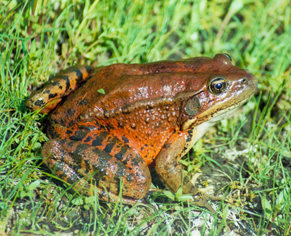
U.S. Fish and Wildlife reverses its stand on endangered
red-legged frog and cuts designated critical habitat by 90
percent
As Earth lovers geared up throughout the nation this week to
celebrate environmental victories, the U.S. Fish and Wildlife
Services announced plans to reduce designated critical habitat for
an endangered frog in California.
U.S. Fish and Wildlife reverses its stand on endangered red-legged frog and cuts designated critical habitat by 90 percent
As Earth lovers geared up throughout the nation this week to celebrate environmental victories, the U.S. Fish and Wildlife Services announced plans to reduce designated critical habitat for an endangered frog in California.
Designated critical habitat for the California red-legged frog was reduced 90 percent – from 4.1 million acres to 450,000. Most of the erased boundaries were in rangelands abutting the Sierra foothills and the frog’s most favored areas along the Central Coast, including areas of south Santa Clara and San Benito counties.
Why should humans care if a species of frog goes extinct? For openers, say scientists and environmentalists, the red-legged frog is an “indicator” species – a canary in a coal mine. If it goes, others are likely to follow.
“Why should we save them? It’s part of the historical legacy of California,” said biologist Marc Hayes, who works from Olympia, Ore., and has been studying the species for more than 30 years. “They were made famous by Mark Twain.”
He refers to Twain’s story “The Celebrated Jumping Frog of Calaveras County,” in which the author launched a famed if not comical reputation for the frog during the 1800s in his recounting of a high stakes frog-jumping contest. Hayes and his associate, scientist Mark Jennings of Davis, are considered among naturalists and frog aficionados as the “gurus of frogs,” the world’s top experts on the state’s red-legged and Northern varieties. The two scientists succeeded in getting the red-legged frog placed on the federal endangered species list in 1996, after years of wrangling with government officials.
Environmentalists believe reducing designated critical habitat means that developers of properties the feds once deemed as possible environments for a species to thrive upon no longer need consult with the U.S. Fish and Wildlife Service or other agencies before proceeding through the planning process. The agency insists that consultations on properties will still be required.
But there’s a bigger picture connected to this political push to eradicate the concept of designated critical habitat from the Endangered Species Act of 1973, an effort driven by industry and development interests such as the Northern California Homebuilders Association, backed by Congressman Richard Pombo, R-Tracy.
“Even more than that, red-legged frogs are an indicator of the health of the aquatic system of California,” Hayes said. “And the assemblage of healthy species has red-legged frogs. If things like the California red-legged frog are the indicators of issues with water quality, those are things that are going to reflect back on humans. It is certainly reflective of the political environment.”
To ask those involved, the fight over the frog boils down to this: how much land are we willing, as humans, to save from development, and how much do we need for a species other than humans to thrive upon?
Critics of widespread critical habitat designation also see the fight over the red-legged frog as a fight for habitat – but they place more importance on human habitat rather than natural habitat.
“The critical habitat provisions in the Endangered Species Act are broken and dysfunctional,” said Paul Campos, Vice President and General Counsel for the Homebuilders Association of Northern California. “We think the critical habitat regime is not an effective way to protect species habitat, and that is a position held widely across the political spectrum.”
Science, mutated by politics
This isn’t the first time U.S. Fish and Wildlife has rendered a decision on the frog’s designated critical habitat. The agency’s record on the issue seems schizophrenic, at best. But perhaps that’s because the bureaucrats are squeezed between opposing lobbyists. The environmental group called Center for Biological Diversity has taken the agency to task, legally, for its proclivity toward burying the notion of designated habitat. Every time the Service acquiesces, usually through court orders, it’s pulled on the other side by the Homebuilders Association of Northern California.
Frog watchers say the agency’s latest decision is based on a flawed economic analysis. Instead of assessing the benefits of saving the frog’s habitat for the public at-large, the agency based the analysis of how it would benefit developers, charges Jeff Miller, spokesman for the Center based in San Francisco, and the result was predictable.
“There’s an interesting dynamic going on with the Bush Administration,” Miller said. “There is an open invitation to industry to challenge the Endangered Species Act. The Bush Administration settles cases brought on by developers or just doesn’t defend against them. That’s when we have to intervene.”
That politics have muddied the science of the issue comes as no surprise to Robert Stack, a widely respected biochemist and frog expert who heads the Jumping Frog Research Institute in Calaveras County.
“The decision is based on politics and not the best available science, and that should be no surprise since were seeing a disturbing pattern in the politicization of science, whether it’s frogs going extinct, or global warming or arsenic in water,” Stack said. “Are we going to be smart about how we develop our land? People need places to live, but so does a frog.”
Scum loving pond dwellers
The red-legged frog, rana aurora draytonii, has become a flashpoint between environmentalists and developers, and where there’s an argument on the amphibian, there’s sure to be a polarized political philosophy. Symbolically, the frog is what the spotted owl was between opposing sides in northern timber country.
Scientists and environmentalists argue that the issue regarding the frog’s designated habitat is not about where the species lives now but where it could live if it were to once again thrive, which is the entire point when a species finally earns “endangered” status. They claim opponents often erroneously believe that much habitat was erroneously deemed critical because none of the species has been found there.
“It’s a recovery driven thing,” Stack said. “If you want to recover a species, by definition, you have to increase its numbers.”
But where do red-legged frogs live now?
Local naturalist Joe Belli has been conducting a red-legged frog survey throughout Henry Coe State Park since 2001. This year he will extend his survey into western Merced, Pacheco State Park and the Upper Cottonwood Creek Wildlife Management Area, a place north of Highway 152 beyond the Santa Clara County boundary, which is managed by the U.S. Fish and Wildlife.
Every spring and summer, Belli dons rubber boots and trudges through the vast riparian ecosystems of the park, including old stock ponds – a favorite breeding ground for the algae-eating amphibian – to do a head count.
Counting these frogs is a dicey business. Only one in 10 juveniles lives to be a year old, and only a fraction of those live to be the ripe old age of 10 or 12. That’s why nature allows the female to lay egg masses between 1,000 and 5,000 eggs.
“I don’t have reason to believe they are increasing, but on the other hand they aren’t disappearing,” Belli said. “Cautiously, I’d say the biggest threat in Coe Park is the introduction of fish or bullfrogs.”
The non-native bullfrogs, the bane of red-legged frog fans, will actually eat red-legged frogs if the meal is small enough to fit inside them.
“It doesn’t surprise me at all what Fish and Wildlife did because for other species they have dragged their feet,” Belli offered. “I don’t doubt that there’s pressure on the service to minimize critical habitat. There are other things at work here. Critical habitat isn’t recovery-oriented nor encouraged by the service, especially in this kind of administration, which isn’t friendly toward environmental efforts.”
Belli said there are few locations where one can find the species anymore, but they are more prevalent back in hills – particularly if there’s a water body like a stock pond in the area – along Pacheco Pass and the land surrounding San Luis Reservoir. In San Benito the species is less numerous since the county is drier, though some have been found along Tres Pinos Creek. More colonies are making a slow comeback at the Pinnacles National Monument off Airline Highway in the southwestern part of the county.
“If you save the red-legged frog through habitat designation, you are being proactive,” Belli said. “You’re helping to prevent future listings of other species, like the southwestern pond turtle, by saving that species. So people who say you’re wasting all this just to save a frog – if the land is treated well and conservation measures are taken, you can prevent other species from going under and getting listed. It’s the trickle down effect.”
An “umbrella species”
Scientist Hayes characterizes the red-legged frog as an “umbrella species:” save it, and you save others, and ultimately yourself.
“The California red-legged frog operates at a spatial scale greater than all the other species,” Hayes said. “If you protect the red-legged frog you will protect a suite of many other species, and that’s why they are a good focal species to address. In terms of conservation and habitat conservation, you can’t address every condition for every critter. So it acts as an umbrella species.”
Melissa Hippard, representative of the Loma Prieta Chapter of the Sierra Club, also emphasizes the importance biodiversity.
“The frogs are part of a larger complex ecosystem,” Hippard said. “We all know there is this creation of intense pressure from development, like all the proposed development in San Benito. But when we think about the quality of life for the frog, we have to think about the quality of life for ourselves. Undeveloped areas provide important environmental services in recharging rain and the aquifers, flood control. It’s a complex scenario, so to simplify it by talking about private property rights doesn’t make sense.”
Officials of Fish and Game in Sacramento say the decision to downplay designated critical habitat is no big thing.
“There’s still two big chunks of designated habitat in Santa Clara County and another big one in San Benito,” said Al Donner, spokesman for the agency.
It’s true that a total of about 57,700 acres in Santa Clara County retain their designated frog habitat status, with another 14,245 in San Benito. But when asked where those habitats are, it became evident that Donner was talking about state and federal parks – Henry Coe and the Pinnacles – areas that are automatically protected by the government. It would be illegal to strip those areas of designated critical habitat status.
But according to the Fish and Wildlife’s own surveys, the South Valley/San Benito region is teeming with federally endangered and threatened species.
Morgan Hill’s list includes many of those species known to still exist in San Benito, with the addition of the Tiburon paintbrush plant. Gilroy’s list includes seven federally threatened species and six endangered ones. It’s much the same as those listed in San Benito, but add a flower, a fish and a bird: the endangered Metcalf Canyon jewelflower, South Central California steelhead and the California Least Tern. Again, the red-legged frog tops both lists.
Big plans, bigger reluctance
A map of participating jurisdictions of the Santa Clara County Open Space Authority says it all: Every city in the county is a member of the agency that strives to preserve open space and greenbelts between cities in the region, with the glaring exception of Gilroy. Where Gilroy sits on the colorful map, a mass of white space occurs.
Between all the recent and upcoming housing projects in the Gilroy planning pipeline, the city and its environs are burgeoning with new development: The gated Eagle Ridge development is due to expand, the Glen Loma project will add 1,000 homes. There’s the 500-home Hecker Pass project coming up, along with hundreds more on Mesa Ridge and the recently approved Rancho del Sol affordable housing project.
Within the next decade, San Jose plans to build an entirely new 20,000-home city in the Coyote Valley area near Morgan Hill to accommodate Silicon Valley workers. Developers now have their eye cast toward the Sargent Ranch near the San Benito border.
In San Benito, developers are hoping to build 6,800 homes in Rancho San Benito, between Hollister and Gilroy, and as many as 4,300 more homes near the Hollister airport for the proposed Del-Webb senior community.
It would cost about $1 million for Gilroy to become a member of the Open Space Authority, and some of that would be levied through property taxes. The city has had two chances to join, once in 1993 and again last year. Both times, city leaders tabled the idea.
“They basically cut the discussion off,” said Alex Kennett, the Open Space Authority representative of the district in which Gilroy would fall. “I feel they made a choice prematurely because they didn’t even want to know how much of that we were willing to pay.”
Former Gilroy Councilman Charles Morales was on the council during both offers, and says the issue revolved around money and hardball political tactics.
“In 1993, we wanted some development,” said Morales, known for his strong stand on environmental causes. “Where it became a political thing is that there were proponents of development who used scare tactics who said that the open space authority would have too much control and authority.
“But citizens are sensing we are growing too fast, too many houses,” Morales added. “We thought we had a gauge with RDO exemptions [the point system that rewards developers for mitigating habitat and sweetening their deals with community public works], but we don’t have enough safeguards any longer.”
Donner of the U.S. Fish and Wildlife insists that the slash in designated habitat for the red-legged frog does not make paving over open spaces any easier for developers.
“It does not loosen restrictions for them,” Donner said. “Just listing the species puts in the protection. If you have the species on your property and you propose to change it, you still need to consult with us even if it’s no longer critical habitat. The protocols are still in place and developers know that.”
“In Gilroy and San Benito, we do not live in a vacuum with the old way of doing politics,” Morales said. “We have to start collaborating regionally because in the long run every municipality is going to be impacted by every development.”
Solutions on the ground
There might be a way out of the quagmire for both landowners and environmentalists, and Robert Stack seems to have found the working solution.
In 2003, several of the frogs were found in a stock pond on a ranch in Calaveras County, the place where the frogs initially found their fame. The discovery stunned and thrilled frog fans throughout the state, and the Jumping Frog Research Institute, well, jumped on the opportunity. Their goal was to make the discovery a win-win for both rancher and frog.
“The solution was to design dual-function ponds, to meet the needs of the frogs and provide water for the cattle,” Stack said.
Working with the rancher and his family, Stack and his staff helped construct the ponds in 2004.
“The (rancher’s) children are plugged into this project,” Stack added. “They are doing surveys looking for frogs, and we have empowered them as junior biologists.”
For a total of about $1,800, funded by the Institute and in part by the U.S. Fish and Wildlife, the ponds could turn out to be an elegant solution to a statewide battle that has, at times, turned vitriolic.
“In spring of 2005 we were delighted to see that the frogs had discovered the ponds on their own moved in and set up home,” Stack said. “For 2006, it’s breeding season right now, so we’re keeping our fingers crossed. We haven’t seen any new egg masses yet, but when we do, we’ll yell ‘Eureka!'”
“How much habitat are we going to pave and how much are we going to save?” Hippard asked rhetorically. “I think that people need to understand it’s not just tree-hugging, frog-loving people resisting this. If they want to convert every square foot of these area for human habitat, we can’t benefit.”









